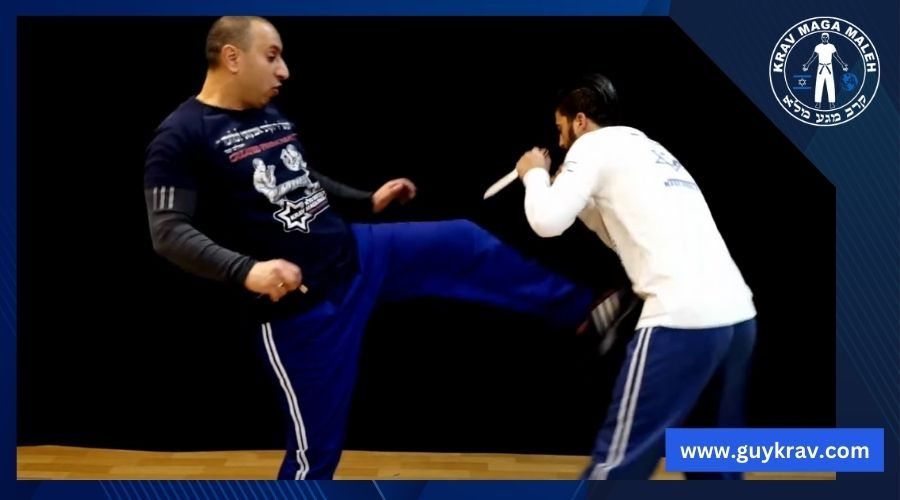Are you interested in becoming a Krav Maga Maleh Instructor? This article will guide you through the essential techniques, teaching strategies, and certification requirements to kickstart your journey onto being a Krav Maga Instructor.
Why become a Krav Maga Maleh instructor?
Becoming a Krav Maga Maleh Instructor offers numerous benefits. It allows you to share your passion for self-defense, help others build confidence, and empower them to protect themselves. As an instructor, you become part of a global community dedicated to improving personal safety and promoting fitness.

Essential Techniques for a Krav Maga Maleh Instructor
To become a proficient Krav Maga Maleh instructor, you need to master a range of essential techniques.
Basic strikes and kicks
Effective striking and kicking techniques form the foundation of Krav Maga Maleh. You’ll learn how to deliver powerful punches, elbow strikes, knee strikes, and various kicks. These techniques are designed to maximize impact while minimizing the risk of injury to yourself.
Defensive maneuvers
Krav Maga Maleh teaches you how to defend against common attacks, such as punches, kicks, and grabs. You’ll practice blocking, parrying, and redirecting the attacker’s force. This system emphasizes quick reflexes and efficient movements to neutralize threats effectively.
Ground fighting techniques
In real-life situations, confrontations might end up on the ground. Krav Maga Maleh equips you with ground fighting techniques, including submissions, escapes, and strikes from a disadvantaged position. Learning how to defend yourself on the ground is crucial for comprehensive self-defense training.
Krav Maga Maleh Instructor: Teaching Strategies
As a Krav Maga Maleh instructor, your teaching strategies play a vital role in creating a positive and effective learning environment.
Creating a safe learning environment
Safety should be a priority in any Krav Maga Maleh class. You’ll learn how to set up the training space, ensure proper equipment usage, and establish rules to prevent injuries. Additionally, creating a supportive and inclusive atmosphere encourages students to develop their skills.
Effective communication with students
Clear and concise communication is key to being an exceptional instructor. You’ll learn how to provide instructions that are easy to understand, offer constructive feedback, and motivate students to achieve their best.
Structuring classes
Structuring your classes in a logical and progressive manner enhances the learning experience. You’ll learn how to plan and organize class content, warm-up exercises, skill-building drills, and practical application sessions..
Krav Maga Maleh Instructor: Certification Requirements
Becoming a certified Krav Maga instructor involves fulfilling certain requirements and undergoing training.
Training and experience
To become an instructor, you must first become proficient in Krav Maga Maleh yourself. Extensive training and practical experience are essential to understanding the system and its principles. Dedicate time to practice, attend workshops, and learn from experienced instructors to hone your skills.
Instructor certification process
Each Krav Maga Maleh organization may have its own certification process. Typically, it involves demonstrating your technical proficiency, teaching abilities, and passing written exams. Contact reputable Krav Maga Maleh schools or organizations to learn more about certification requirements and processes.
Continuing education
Once you become a certified Krav Maga Maleh instructor, your learning journey doesn’t stop. Continuous improvement is crucial to staying up-to-date with new techniques, refining your skills, and deepening your understanding of self-defense. Attend seminars, workshops, and advanced training courses to expand your knowledge and expertise.

Getting Started
Now that you understand the essential techniques, teaching strategies, and certification requirements, it’s time to kickstart your journey as a Krav Maga Maleh instructor.
Finding a reputable Krav Maga Maleh school
Start by researching and identifying reputable Krav Maga Maleh schools or organizations in your area. Look for those with a strong reputation, experienced instructors, and a comprehensive curriculum. Reading reviews and testimonials can also provide valuable insights.
Enrolling in instructor training courses
Once you’ve found a suitable school, inquire about their instructor training programs. They provide comprehensive training, including theoretical knowledge, practical skills, teaching methodologies, and supervised teaching practice.
Practicing and refining your skills
Becoming a proficient instructor requires continuous practice and refinement of your own skills. Dedicate time to regular training sessions, attend workshops, and seek feedback from experienced practitioners and instructors.
Conclusion
Starting your Krav Maga Maleh instructor journey opens doors to a rewarding and fulfilling path. By mastering essential techniques, adopting effective teaching strategies, and fulfilling certification requirements, you’ll be prepared to empower others with life-saving skills.
FAQs
How long does it take to become a Krav Maga Maleh instructor?
The time required to become a Krav Maga Maleh instructor varies depending on your dedication, training frequency, and the specific certification process. It typically takes several years of consistent training and practical experience.
Do I need prior martial arts experience to become a Krav Maga Maleh instructor?
While prior martial arts experience can be helpful, it is not mandatory. Krav Maga Maleh is designed to be accessible to individuals of all backgrounds and fitness levels.
Can I teach Krav Maga Maleh as a part-time instructor?
Yes, you can choose to teach Krav Maga Maleh as a part-time instructor. Many instructors begin by teaching classes in the evenings or weekends while maintaining other employment.
Can I open my own Krav Maga Maleh school after becoming an instructor?
Yes, becoming a certified Krav Maga Maleh instructor provides you with the knowledge and skills necessary to open your own school or training facility. However, it’s important to conduct thorough research, develop a business plan, and ensure you have the required resources to start and sustain a successful school.







